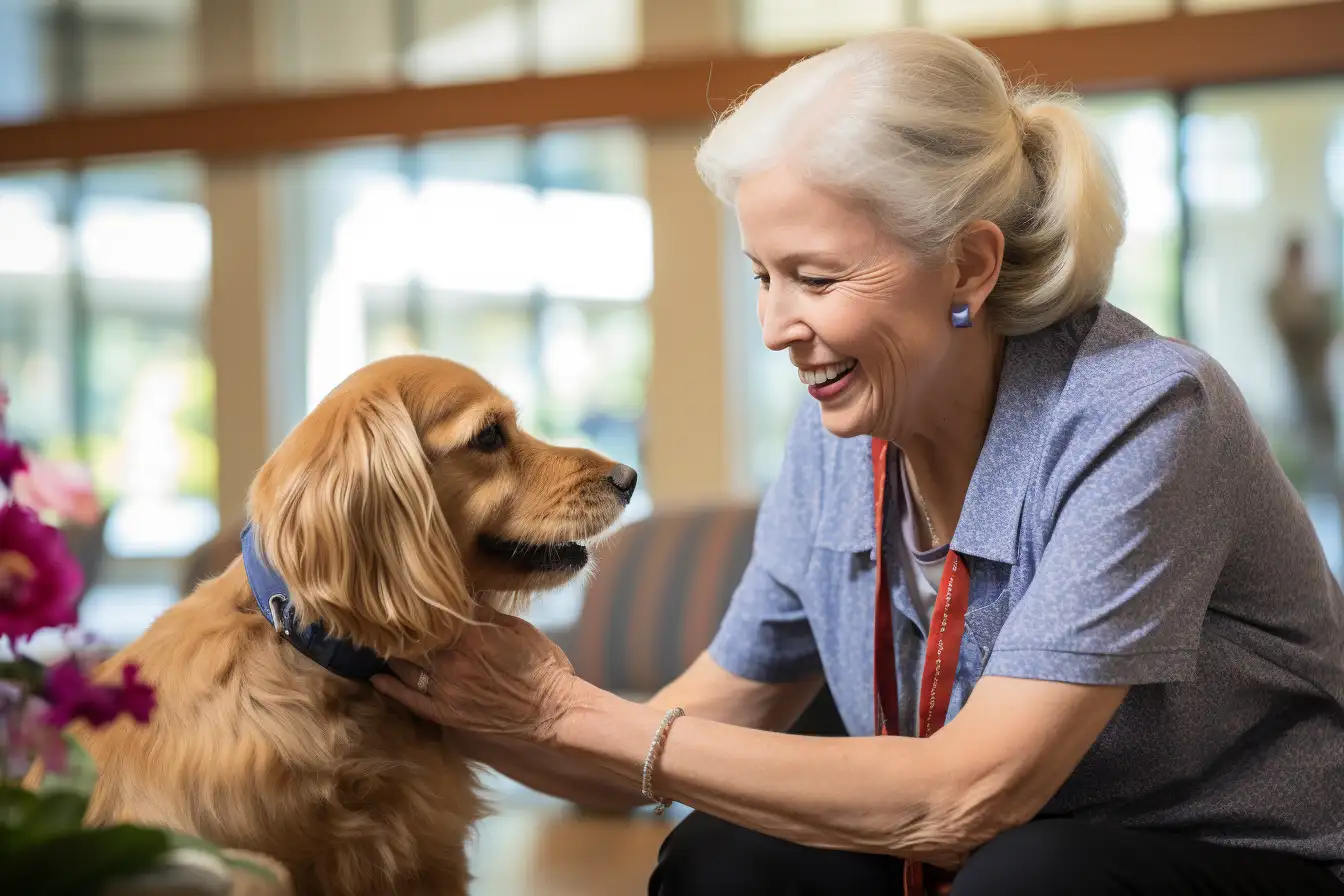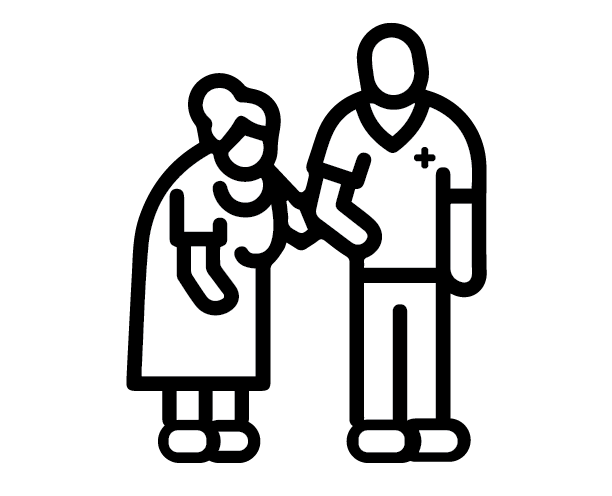The Healing Power of Hospice Pet Therapy
If you’re engaged in caring for hospice patients and are looking for innovative methods to offer comfort and solace, recent research indicates that animal-assisted therapy (AAT), popularly known as pet therapy, delivers significant benefits for people navigating the end of their lives.
This blog will delve into the world of hospice pet therapy – how pets interact with patients, what training entails for these remarkable animals, and how this practice positively impacts the quality of life during such a precious time.
Buckle in; we’re going on an enlightening journey!
Key Takeaways
- Pets bring joy to people in hospice care. They provide unconditional love that cuts stress.
- Pet therapy helps make patients feel good inside and out.
- Before pets can help, they must go through training and get a badge.
- Volunteers play a big part. They work closely with the pets and patients.

Benefits of Hospice Pet Therapy
Hospice pet therapy brings immense mental advantages, offering patients emotional upliftment, social connections, and significant physical benefits. It provides solace for the distressed soul, making patients feel loved and understood without uttering words.
You’ll notice an easing of patient anxiety levels as interactions with these animals can lower blood pressure while encouraging movement in physical therapy sessions. This therapy offers more than companionship – it invites laughter, triggers memories, and creates enriching experiences that transcend traditional treatments in hospice care.
Mental health and emotional benefits of pet therapy in hospice
Pet therapy provides significant mental health benefits for hospice patients. Interacting with pets can help patients in the following ways:
- Alleviates stress and worries – Being with a friendly pet promotes relaxation and reduces anxious thoughts. The calming presence of an animal can create a peaceful atmosphere.
- Lifts mood and spirits – Petting and playing with a dog, cat, or other animal releases feel-good hormones like oxytocin and serotonin. This boosts happiness and eases depression.
- Provides comfort through touch – Stroking soft fur and getting hugs from pets is soothing. Physical contact with a caring animal is therapeutic.
- Offers non-judgmental companionship- Pets are caring friends who listen attentively. They provide unconditional acceptance, which is comforting.
- Creates joyful moments – The playful antics of pets make people smile. Brief moments of lightness and laughter can improve a hospice patient’s outlook.
Pet therapy can significantly benefit hospice patients’ mental well-being. The companionship and affection from animals can relieve distress, improve mood, and bring moments of joy. Considering pet therapy as part of holistic hospice care is highly recommended.

CONTINUA LEARNING
Simplify Your Hospice Team’s Training and Skill Building
A complete solution for your agency: more than 125 hospice courses, caregiver in-services, training plans, and more.
Physical benefits of pet therapy in hospice
In addition to the emotional and mental health benefits of pet therapy in hospice, interacting with therapy animals can positively impact patients’ physical in the following ways:
- Lowers blood pressure and heart rate: The act of petting and stroking an animal has been shown to decrease stress hormones and promote relaxation. This helps stabilize blood pressure.
- Soothes pain: Studies indicate spending time with pets can temporarily reduce feelings of pain and discomfort. The release of endorphins during pet interactions may contribute to pain relief.
- Promotes overall relaxation: The calming presence of pets reduces muscle tension, lowers anxiety, and induces tranquility. This facilitates deep relaxation for both the mind and body.
- Motivates movement and activity: Walking, playing, and caring for pets encourage patients to engage in therapeutic physical activity and exercise. This can counteract the tendency towards inactivity.
- Provides comforting touch: For bedbound or frail patients, gentle contact with a soft pet can bring comfort and ease pain. Stroking an animal is soothing.
Pet therapy provides tangible physical benefits for hospice patients. The companionship of pets not only brings emotional comfort but also enhances patients’ overall physical well-being.

Social benefits of pet therapy in hospice
Now let’s examine the social benefits of pet therapy for hospice patients, which promote connections and community:
- Fosters social interaction: Caring for pets facilitates patient, family, and staff conversation and friendship. New bonds are formed through shared positive experiences.
- Creates a welcoming atmosphere: The presence of pets makes the hospice environment warmer and friendlier. Laughter and smiles break down barriers between people.
- Encourages family involvement: Pets motivate family members, even children, to visit and participate in a patient’s care. This strengthens family ties.
Pet therapy delivers social and community benefits for hospice patients and families. Caring for pets together lays the foundation for meaningful connections.

How Pets Interact with Hospice Patients During Visits
When pet therapy animals visit hospice patients, their interactions can take many forms. The pets and handlers are trained to be calm, friendly, and attentive to the patient’s needs. Here are some of the common ways therapy pets connect with hospice patients during visits:
Providing comfort through touch
- Sitting on the bed, allowing patients to pet or stroke them
- Placing their head in a patient’s lap to be petted
- Gently laying across a patient’s feet or legs
- Licking a patient’s hands or face
- Leaning into a patient receiving a hug
The gentle physical contact and tactile stimulation are soothing for patients. Petting the animal releases feel-good hormones and promotes relaxation.
Motivating Patients to Engage
- Entertaining patients by performing tricks like dancing, jumping, or catching treats
- Engaging patients in playing fetch or tug-of-war
- Encouraging patients to brush the animal’s coat
- Getting patients to exercise by walking together around the room or hallway
The therapy animal’s playful spirit and activity motivate patients to participate and stimulate their minds and bodies. This prevents boredom and isolation.
Providing Emotional Support
- Sitting calmly next to a patient during conversations or counseling sessions
- Placing their head sympathetically on a patient’s lap during moments of grief
- Cuddling up to a lonely patient to provide companionship
- Listening attentively to patients sharing stories or voicing worries
- Making encouraging eye contact and responding to emotions
The pets’ unconditional affection and sensitivity to human feelings bring great emotional comfort to patients.
In summary, trained therapy pets interact with hospice patients through touch, play, and companionship tailored to each patient’s needs. This delivers many physical, mental, and emotional benefits for their health and well-being. The loving pets bring joy and solace during a difficult time.

The Journey to Becoming a Certified Therapy Animal in Hospice Care
The path to certification for therapy animals is rigorous, involving meticulous selection, specialized training, and formal certification. The extensive training ensures these animals are well-equipped to provide solace and happiness in the sensitive hospice care environment.
Meeting Certification Requirements
To become a certified therapy animal, specific criteria must be met. These standards are set by reputable organizations like the American Kennel Club (AKC). AKC requires animals to complete multiple observational outings to qualify as therapy animals.
List of Organizations Offering Certification:
- American Kennel Club (AKC)
- The Alliance of Therapy Dogs
- Oklahoma State University’s Pet Therapy Program
In some instances, like at Oklahoma State University, therapy animals must wear specialized identification to signify their role.
The Critical Role of Training and Certification
Training serves as the backbone for preparing therapy animals for their roles. These animals undergo a series of behavioral assessments administered by certified professionals. Moreover, their health is scrutinized by veterinarians to ensure they are fit for the job.
Key Areas of Training and Certification:
- Behavioral Assessments
- Health Checks by Veterinarians
- Specialized Skill Sets
A well-trained animal, combined with effective handlers, can significantly elevate the quality of life for hospice patients.
The Invaluable Contribution of Handlers
Handlers play an indispensable role in the success of pet therapy. They are responsible for ensuring that their animals interact positively with end-of-life patients. They are also trained to recognize signs of stress or fatigue in their animals, which is crucial for maintaining a healthy therapy environment.
Handler Training Components:
- 8-10 weeks of specialized training classes
- Learning to interpret non-verbal cues from their animals
- Techniques for facilitating interactions with patients who may have communication challenges
By undergoing rigorous training and certification, handlers enable their therapy animals to communicate effectively, even with patients with limited verbal or physical responsiveness.

The Role of Hospice Therapy Dogs
How They Serve
- Emotional Support: Therapy dogs in hospice settings offer invaluable emotional comfort to patients, easing feelings of loneliness and depression.
- Physical Benefits: Their presence can lower blood pressure and reduce anxiety, contributing to a patient’s overall well-being.
Training and Temperament
- Specialized Training: These dogs undergo specific training to handle the sensitive nature of hospice care, ensuring they are calm and responsive to patient needs.
- Gentle Companions: They are selected for their gentle demeanor and ability to interact patiently and kindly with patients.
Hospice therapy dogs play a crucial role in providing comfort and support to patients in end-of-life care. Their training and natural compassion make them ideal companions in these settings, offering both emotional solace and physical benefits.
Implementing Pet Therapy in Hospice Care: A Compassionate Approach
Integrating pet therapy into hospice care is more than a trend; it’s a compassionate strategy aimed at improving patients’ lives. With the help of devoted pet volunteers, hospice settings become havens of love, comfort, and emotional support.
The vital role of pet volunteers
Pet volunteers are the backbone of successful pet therapy programs in hospices. They bring their specially trained animals to engage with patients, offering an irreplaceable sense of warmth and companionship. These volunteers ensure patients feel secure and joyful during these therapeutic visits.
Key responsibilities of pet volunteers:
- Emotional support through animal interaction
- Ensuring patient safety during visits
- Assisting in activity planning with healthcare providers
Specialized training for therapy pets
Pets in hospice care undergo rigorous training to prepare them for this delicate environment. Their roles are pivotal—they alleviate stress, combat loneliness, and comfort those most vulnerable.
Benefits provided by trained therapy pets:
- Stress Reduction
- Emotional Comfort
- Combatting Loneliness
It’s important to note that pet therapy programs are only successful with the selfless contributions of volunteers. They are the heart and soul that drive the program’s success.
The impact of in-home pet therapy programs
In-home pet therapy programs offer a personalized approach for patients who prefer the comfort of their homes. Trained animals visit patients in their residences, fostering a sense of companionship that’s particularly impactful for those who may be isolated.
Safety measures in in-home programs:
- Risk assessments before visits
- Proper animal health certifications
- Supervision by trained handlers
The focus is not only on emotional well-being but also on ensuring that the therapy is conducted safely.
Conclusion
Hospice pet therapy uplifts patients’ spirits through unconditional affection from trained animals. The human-animal bond offers unique comfort and joy when curative options are exhausted. Although implementing pet therapy requires commitment from volunteers and staff, the rewards are immeasurable. The warmth and love of these animal companions enrich the human spirit and enhance dignity at life’s end. Pets bring light during darkness.
FAQs
What is hospice pet therapy?
Hospice pet therapy is a type of comfort care where pets visit patients and their families at the end of life to help reduce anxiety, provide comfort, and offer various emotional and physical benefits.
Can pets offer therapy in assisted living facilities?
Yes, pet therapy can also be done in assisted living facilities to provide relief and happiness to those who live there.
Who brings the pets for hospice pet therapy?
Trained and dedicated volunteers working in hospice bring their specially trained animals to interact with patients. These volunteers coordinate with hospice providers to ensure safe and effective therapy sessions.
How does hospice pet therapy provide comfort to hospice patients and their families?
Hospice pet therapy provides comfort through a guided interaction between therapy dogs and patients. This emotional connection can have a positive effect on the patient’s mood and overall well-being. The presence of a friendly pet can also offer a sense of normality and companionship in challenging times, providing some relief for the patient and also the caregiver.
What are the benefits of pet therapy in hospice care?
The benefits of pet therapy in hospice care are numerous. For starters, it provides an emotional connection which can combat feelings of loneliness and isolation. Physical benefits of hospice pet interaction can include lowering blood pressure, improving cardiovascular health, and releasing endorphins that produce a calming effect. It’s well-known that this interaction can uplift spirits and provide comfort to patients.
How does a typical hospice pet therapy visit look like?
During a hospice pet therapy visit, the therapy dog arrives with its handler, who is usually a hospice pet therapy volunteer. They visit the patient’s room and interact with the patient per the patient’s comfort level. This encounter can vary from simply being in the room with the patient to the patient petting the animal or even just placing a paw in their hand.
What are the qualifications for the dogs in hospice pet therapy programs?
Dogs in hospice pet therapy programs typically go through rigorous training and certification. Many are certified through organizations like Therapy Dogs International (TDI). They need to be calm, compassionate and have a history of providing comfortable and positive interactions.
What does the process of training and certification for hospice pet therapy involve?
The training and certification for a hospice pet therapy animal begins with general obedience training. The animal needs to be calm, intuitive, and friendly. After they are trained, they can begin their certification progress through an organization like TDI. This typically involves assessment of the dog’s behavior around people, particularly sensitive situations like hospice care environments.
How do therapy work animals interact with hospice patients?
A: Therapy animals interact with hospice patients in a number of ways. They can simply exist in the room giving a sense of companionship, or they can be petted, or interact with patients to a level that the patient is comfortable with. These interactions help create an emotional connection that uplifts the spirit of the patients and helps them feel more comfortable and less isolated.
Are hospice staff involved in hospice pet therapy visits?
Yes, the hospice staff are an integral part of the hospice pet therapy program. They liaison with the pet therapy volunteer, coordinate the visits and ensure the safety and comfort of the patient during the visit. They are also there to answer any questions or cater to any needs that might arise during a therapy visit.
How did hospice pet therapy programs become a part of hospice care?
Hospice pet therapy programs became a part of hospice care due to the increasing recognition of their positive effects on patients. Research and numerous clinical experiences have shown that therapy animals can bring significant emotional comfort, promote an optimistic outlook, and even have physical benefits for patients, making it not just a regular part of many hospice care programs.

